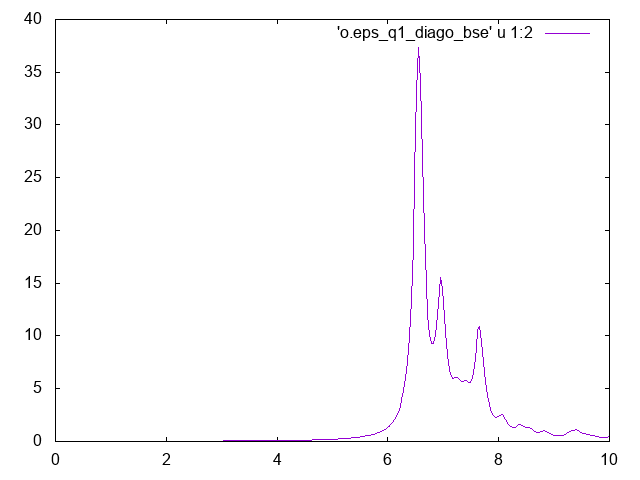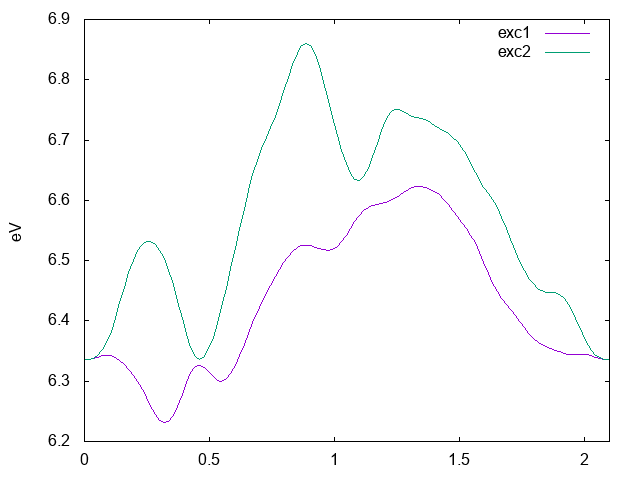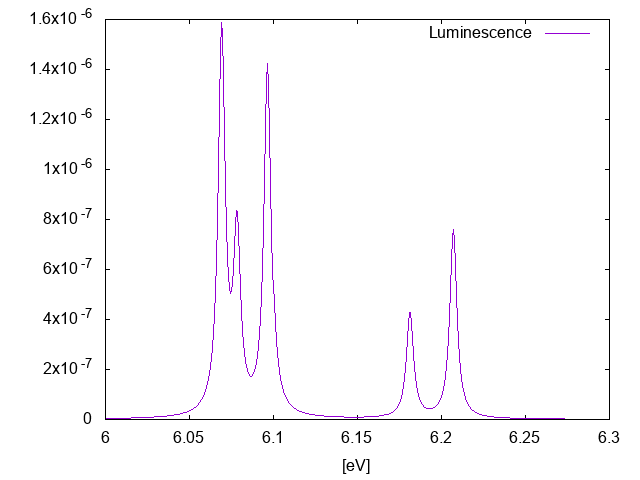Exciton-phonon coupling and luminescence: Difference between revisions
No edit summary |
No edit summary |
||
| Line 1: | Line 1: | ||
This an advanced tutorial, we will show how calculate exciton-phonon coupling<ref>Optical processes in solids, Toyozawa, Yutaka, and Chris Oxlade. Cambridge University Press, (2003). </ref> and <span style="color:red"> phonon-assisted absorption/emission</span><ref name='pierre'>[https://arxiv.org/abs/2212.10407, First-principles study of luminescence in hexagonal boron nitride single layer: Exciton-phonon coupling and the role of substrate], | This an advanced tutorial, we will show how calculate exciton-phonon coupling<ref>Optical processes in solids, Toyozawa, Yutaka, and Chris Oxlade. Cambridge University Press, (2003). </ref> and <span style="color:red"> phonon-assisted absorption/emission</span><ref name='pierre'>[https://arxiv.org/abs/2212.10407, First-principles study of luminescence in hexagonal boron nitride single layer: Exciton-phonon coupling and the role of substrate], | ||
P Lechifflart, F Paleari, D Sangalli, C Attaccalite PRM '''7''' (2), 024006 (2023)</ref>. Finally we will show how the exciton-phonon coupling can be used to calculate exicton life-time. | P Lechifflart, F Paleari, D Sangalli, C Attaccalite PRM '''7''' (2), 024006 (2023)</ref>. <br>Finally we will show how the exciton-phonon coupling can be used to calculate exicton life-time. | ||
In order to run this tutorial you need a deep knowledge of the theory involving these processes and on the use of the Yambo code. <ref name='cann'>[https://arxiv.org/abs/1807.11797 Theory of phonon-assisted luminescence in solids: Application to hexagonal boron nitride], E. Cannuccia, B. Monserrat and C. Attaccalite, Phys. Rev. B '''99''', 081109(R) (2019)</ref><ref name='fprl'>[https://arxiv.org/abs/1810.08976 Exciton-Phonon Coupling in the Ultraviolet Absorption and Emission Spectra of Bulk Hexagonal Boron Nitride], F. Paleari et al. PRL '''122''', 187401(2019) </ref><ref name='bern'>[https://arxiv.org/abs/2002.08913 Exciton-Phonon Interaction and Relaxation Times from First Principles], | In order to run this tutorial you need a deep knowledge of the theory involving these processes and on the use of the Yambo code. <ref name='cann'>[https://arxiv.org/abs/1807.11797 Theory of phonon-assisted luminescence in solids: Application to hexagonal boron nitride], E. Cannuccia, B. Monserrat and C. Attaccalite, Phys. Rev. B '''99''', 081109(R) (2019)</ref><ref name='fprl'>[https://arxiv.org/abs/1810.08976 Exciton-Phonon Coupling in the Ultraviolet Absorption and Emission Spectra of Bulk Hexagonal Boron Nitride], F. Paleari et al. PRL '''122''', 187401(2019) </ref><ref name='bern'>[https://arxiv.org/abs/2002.08913 Exciton-Phonon Interaction and Relaxation Times from First Principles], | ||
Hsiao-Yi Chen, Davide Sangalli, and Marco Bernardi, Phys. Rev. Lett. '''125''', 107401(2020)</ref> | Hsiao-Yi Chen, Davide Sangalli, and Marco Bernardi, Phys. Rev. Lett. '''125''', 107401(2020)</ref> | ||
Revision as of 16:06, 1 September 2023
This an advanced tutorial, we will show how calculate exciton-phonon coupling[1] and phonon-assisted absorption/emission[2].
Finally we will show how the exciton-phonon coupling can be used to calculate exicton life-time.
In order to run this tutorial you need a deep knowledge of the theory involving these processes and on the use of the Yambo code. [3][4][5]
We will consider as example bulk hBN. Notice that parameters of the present tutorial are not at convergence, but are just as a possible example.
The tutorial includes several steps and the calculations can be quite expensive.
Getting the code
This tutorial works only with Yambo version > 6.x, but a preliminary version of the code is available on github:
https://github.com/attacc/yambo-excph
Notice that this version is for testing purpose only, it's not fully tested therefore we advice you do not use it in production. In order to install yambo with exciton-phonon coupling you do:
git clone git@github.com:attacc/yambo-excph.git cd yambo-excph ./configure make core make ph-project
Electron-phonon matrix elements
Here you will find a script and all input files to run the a small example on hBN:
In the tgz file you will find a script run_dvscf.sh a python script and different folders with the QE input files. You have to modify run_dvscf.sh in order to set the correct path of Yambo and QuantumEspresso on your PC, the number of processors to use, and the parallelization command. Then run:
./run_dvscf.sh
it will generate electron-phonon coupling on a Q-grid 12x12x1 for bulk hBN. Generation of electron-phonon matrix elements can take time, one my PC (core i9) it takes 1 hour with 8 cores, you can decrease the number of k-point to 8x8 to speed up calculations. The script will perform self-consistent calculation for the density, then non-self-consistent for the band structure, calculation of phonons on a special q-grid and finally the calculation of electron-phonon matrix elements. All these data, wave-functions, and electron-phonon matrix elements are then transformed in the Yambo format.
You can go in the QPT12/dvscf/bn.save folder and start calculation from here.
BSE at finite momentum
Run the BSE for all momentum q as explained in the tutorials: BSE basic, BSE convergence, BSE for 2D.
Do not forget to turn on the flag WRbsWF to write the excitonic wave-functions.
You can generate the input for the BSE with the command: yambo_ph -X s -o b -y d -V qp -k sex
em1s # [R][Xs] Statically Screened Interaction optics # [R] Linear Response optical properties bss # [R] BSE solver bse # [R][BSE] Bethe Salpeter Equation. dipoles # [R] Oscillator strenghts (or dipoles) BoseTemp=-1.000000 eV # Bosonic Temperature DIP_Threads=0 # [OPENMP/X] Number of threads for dipoles X_Threads=0 # [OPENMP/X] Number of threads for response functions K_Threads=0 # [OPENMP/BSK] Number of threads for response functions Chimod= "HARTREE" # [X] IP/Hartree/ALDA/LRC/PF/BSfxc BSKmod= "SEX" # [BSE] IP/Hartree/HF/ALDA/SEX/BSfxc BSEmod= "resonant" # [BSE] resonant/retarded/coupling BSSmod= "d" # [BSS] (h)aydock/(d)iagonalization/(s)lepc/(i)nversion/(t)ddft` BSENGexx= 14923 RL # [BSK] Exchange components BSENGBlk=-1 RL # [BSK] Screened interaction block size [if -1 uses all the G-vectors of W(q,G,Gp)] #WehCpl # [BSK] eh interaction included also in coupling KfnQPdb= "none" # [EXTQP BSK BSS] Database action KfnQP_INTERP_NN= 1 # [EXTQP BSK BSS] Interpolation neighbours (NN mode) KfnQP_INTERP_shells= 20.00000 # [EXTQP BSK BSS] Interpolation shells (BOLTZ mode) KfnQP_DbGd_INTERP_mode= "NN" # [EXTQP BSK BSS] Interpolation DbGd mode % KfnQP_E 3.000000 | 1.000000 | 1.000000 | # [EXTQP BSK BSS] E parameters (c/v) eV|adim|adim % % BSEQptR 1 | 19 | # [BSK] Transferred momenta range % % BSEBands 7 | 10 | # [BSK] Bands range % % BEnRange 0.00000 | 10.00000 | eV # [BSS] Energy range % % BDmRange 0.100000 | 0.100000 | eV # [BSS] Damping range % BEnSteps= 300 # [BSS] Energy steps % BLongDir 1.000000 | 0.000000 | 0.000000 | # [BSS] [cc] Electric Field % BSEprop= "abs" # [BSS] Can be any among abs/jdos/kerr/magn/dich/photolum/esrt BSEdips= "none" # [BSS] Can be "trace/none" or "xy/xz/yz" to define off-diagonal rotation plane WRbsWF # [BSS] Write to disk excitonic the WFs % BndsRnXs 1 | 16 | # [Xs] Polarization function bands % NGsBlkXs= 51 RL # [Xs] Response block size % LongDrXs 1.000000 | 0.000000 | 0.000000 | # [Xs] [cc] Electric Field %
In the BSE we included only the two top valence bands 7,8 and the bottom conduction bands 9,10, a scissor of 3.0 eV, and the dielectric constant used to calculate W include 16 bands and a block size of 51 plane waves. Notice that we calculate the BSE for all the 19 possible transfer momentum. In this input file we used the full diagonalization BSSmod= "d" , for large system it is better to switch to the Slepc libraries '-y s' in the input file generation. If you plot the optical spectra, the file o.eps_q1_diago_bse you should get something like this:
Exicton dipersion
Just to be sure that everything is fine, we can have a look to the exciton dispersion along the path Gamma->K->M->Gamma, with the command: ypp_ph -e i
excitons # [R] Excitonic properties interpolate # [R] Interpolate INTERP_mode= " BOLTZ" # Interpolation mode (NN=nearest point, BOLTZ=boltztrap aproach) INTERP_Shell_Fac= 20.00000 # The bigger it is a higher number of shells is used INTERP_NofNN= 1 # Number of Nearest sites in the NN method BANDS_steps= 50 # Number of divisions cooIn= "rlu" # Points coordinates (in) cc/rlu/iku/alat cooOut= "rlu" # Points coordinates (out) cc/rlu/iku/alat States= "1 - 2" # Index of the BS state(s) % INTERP_Grid -1 |-1 |-1 | # Interpolation BZ Grid % #PrtDOS # Print Exciton Density of States % DOSERange 1.000000 |-1.000000 | eV # Energy range % DOSESteps= 10 # Energy steps DOS_broad= 0.100000 eV # Broadening of the DOS %BANDS_kpts # K points of the bands circuit 0.0 | 0.0 | 0.0 | 0.33333333333| 0.333333333333 | 0.0 | 0.5 | 0.0 | 0.0 | 0.0 | 0.0 | 0.0 | %
In the following figure the excitonic dispersion for the first two states, where you can see that the system is indirect because the minimum is not a Gamma.
Exciton-phonon matrix elements and optics
Now that you have the BSE for all momentum and the gkkp_expanded databases you can create the exciton-phonon matrix elements, according to the equation:
and calculate optical response as:
where Wβα,μq =Eβq − Eα + ωqμ ,for more details see Ref.[6]. Phonon-assisted optical response and exciton-phonon matrix elements can be calculated with the command: yambo_ph -excph o
excph # [R] Exction-phonon ExcGkkp # [R][EXCPH] Exciton-Phonon Matrix Elelements ExcPhOptics # [R][EXCPH] Exciton-Phonon Optics BoseTemp= 0.000000 eV # Bosonic Temperature % ELPhExcStates 1 | 4 | # [EXCPH] Incoming (external) exciton states % % ELPhExcSum 1 | 8 | # [EXCPH] Outgoing (virtual) exciton states % LoutPath= "none" # [EXCPH] Path of the outgoing L FANdEtresh= 10.00000 meV # [ELPH] Energy treshold for Fan denominator LDamping= 0.500000E-3 eV # [EXCPH] Damping of exc-ph self-energy EXCTemp= 20.00000 Kn # [EXCPH] Excitonic Temperature (for luminescence spectra) % ElPhModes 1 | 12 | # [ELPH] Phonon modes included % AlphaQ= 0.000000 # [EXCPH] Excitonic band structure 2D distortion #PLqres # [EXCPH] Write contribution from each q-point #DbGdOnlyPh # [EXCPH] Use Double-Grid only for phonon energies (do not interpolate excitons) #DbGdWEIGHTs # [EXCPH] Use Double-grid also for satellite weights and renormalization #NoMatrxEl # [EXCPH] Set all exciton-phonon matrix elements to one (for testing purpose) % EnRngeXd 5.800000 | 6.400000 | eV # [Xd] Energy range % % DmRngeXd 0.002500 | 0.002500 | eV # [Xd] Damping range % ETStpsXd= 1000 # [Xd] Total Energy steps EXCPHdEtresh= 0.100000E-5 eV # [ELPH] Energy treshold for exc-ph denominator
where the ELPhExcStates state are the one responsible for the absorption and emission, the α indexes in the χαα and ELPhExcSum are the virtual exciton states that enter in the exciton-phonon scattering, namely the β index in the sum χαα. Running the code, Yambo calculates all the exciton-phonon matrix elements and the photon assisted absorption and emission spectra. The emission spectra is calculated using the Roosbroeck–Shockley (RS) relation[7], a Boltzman distribution for the excitonic occupation at temperature EXCTemp, for more detail see Refs.[6][4], other ways for excitonic occupations are possible, for a discussion see Ref.[3].
LoutPath is the path of the outgoing Bethe-Salpeter, in principle one can use two different kind of exciton for virtual and real exciton in above equation. If LoutPath='none' Yambo will read excitons in the same folder of the incoming ones, by default the SAVE folder.
Double grid for exciton and phonon energies is available[2], in order to activate it just generate phonons on large grids and make Yambo reads them, as explained in the electron-phonon tutorial. Yambo automatically will interpolate exciton on the same grid. Using the double-grid, in order to converge results on q-grid you can follow the same advices of the electron-phonon tutorial.
In the output are present two file, the absorption and the luminescence spectra. The absorption is not so interesting because is dominated by a strong direct exciton and phonon-assisted peaks are only slightly visible. Hereafter we plot the luminescence spectrum that can be compared with the ones of Ref.[2][4][5].
Exciton lifetimes
Using the exciton-phonon coupling it is possible also to calculate exciton life-time due to the scattering with phonon. For this kind of calculation input file can be generated with the command yambo -excph l:
excph # [R] Exction-phonon ExcGkkp # [R][EXCPH] Exciton-Phonon Matrix Elelements ExcPhLifeT # [R][EXCPH] Exciton-Phonon Life-Times BoseTemp= 0.000000 eV # Bosonic Temperature % ELPhExcStates 1 | 4 | # [EXCPH] Incoming (external) exciton states % % ELPhExcSum 1 | 8 | # [EXCPH] Outgoing (virtual) exciton states % LoutPath= "none" # [EXCPH] Path of the outgoing L FANdEtresh= 0.100000E-5 eV # [ELPH] Energy treshold for Fan denominator % ElPhModes 1 | 12 | # [ELPH] Phonon modes included % EXCTemp= 0.000000 eV # [EXCPH] Excitonic Temperature (for luminescence spectra) AlphaQ= 0.000000 # [EXCPH] Excitonic band structure 2D distortion #ExcPhOffDiago # [EXCPH] Exciton-Phonon off-diagonal self-energy #NoMatrxEl # [EXCPH] Set all exciton-phonon matrix elements to one (for testing purpose) LDamping= 0.1 meV # [EXCPH] Damping of exc-ph self-energy
notice that in this case LDamping is the broadening of the exciton-phonon self energy and it should be a very small value of the order of the phonon life-times around the meV.[8]. Running this input you will get:
<---> Exciton lifetimes: <---> Exciton [1] Lifetime: 0.697314 meV <---> Exciton [2] Lifetime: 0.697314 meV <---> Exciton [3] Lifetime: 20.22155 meV <---> Exciton [4] Lifetime: 32.95292 meV
the life-time of the first four excitons. Note that this result is not converged in the q-points. In order to speedup convergence that double-grid[2] can be used also in the life-time calculations.
References
- ↑ Optical processes in solids, Toyozawa, Yutaka, and Chris Oxlade. Cambridge University Press, (2003).
- ↑ 2.0 2.1 2.2 2.3 First-principles study of luminescence in hexagonal boron nitride single layer: Exciton-phonon coupling and the role of substrate, P Lechifflart, F Paleari, D Sangalli, C Attaccalite PRM 7 (2), 024006 (2023)
- ↑ 3.0 3.1 Theory of phonon-assisted luminescence in solids: Application to hexagonal boron nitride, E. Cannuccia, B. Monserrat and C. Attaccalite, Phys. Rev. B 99, 081109(R) (2019)
- ↑ 4.0 4.1 4.2 Exciton-Phonon Coupling in the Ultraviolet Absorption and Emission Spectra of Bulk Hexagonal Boron Nitride, F. Paleari et al. PRL 122, 187401(2019)
- ↑ 5.0 5.1 Exciton-Phonon Interaction and Relaxation Times from First Principles, Hsiao-Yi Chen, Davide Sangalli, and Marco Bernardi, Phys. Rev. Lett. 125, 107401(2020)
- ↑ 6.0 6.1 First-principles approaches to the description of indirect absorption and luminescence spectroscopy: exciton-phonon coupling in hexagonal boron nitride, F. Paleari PhD thesis
- ↑ Photon-Radiative Recombination of Electrons and Holes in Germanium, W. van Roosbroeck and W. Shockley, Phys. Rev. 94, 1558 (1954)
- ↑ First-principles calculations of phonon frequencies, lifetimes, and spectral functions from weak to strong an-harmonicity: The example of palladium hydrides, L. Paulatto, et al. Phys. Rev. B 91, 054304 (2015)




